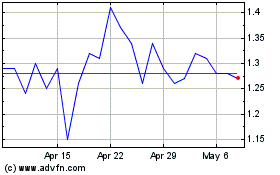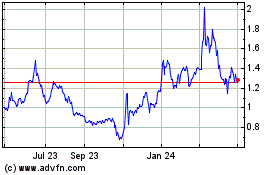Clearside Biomedical, Inc. (NASDAQ:CLSD), a biopharmaceutical
company dedicated to developing and delivering treatments that
restore and preserve vision for people with serious back of the eye
diseases, announced today that multiple clinical poster
presentations related to its suprachoroidal injection platform and
programs were delivered at the Association for Research in Vision
and Ophthalmology 2021 Virtual Meeting which took place May 1-7,
2021.
“The posters delivered at ARVO are increasingly
important as we advance our CLS-AX clinical program and our New
Drug Application for XIPERE™ which is under review by the U.S. Food
and Drug Administration,” said Thomas A. Ciulla, M.D., MBA, Chief
Medical Officer and Chief Development Officer. “The analyses
demonstrate the utility of our proprietary suprachoroidal space
(SCS®) delivery platform to administer small molecules and gene
therapy. The data also continues to validate suprachoroidal
delivery as an office-based, repeatable form of administration for
therapies for multiple retinal disorders.”
Suprachoroidal Space Delivery
Platform
Title: Suprachoroidal injections across
species via multimodal imaging
Lead Author: Allen Ho
Conclusions: This project
compared suprachoroidal and intravitreal injections using
diagnostic imaging and documented three important treatment
attributes of suprachoroidal delivery: 1) acute opening of the
suprachoroidal space; 2) circumferential, posterior spread of
injectate in the suprachoroidal space; and 3) compartmentalization
of injectate to posterior tissues away from anterior and corneal
tissues. In contrast to intravitreal delivery, suprachoroidal drug
delivery targets chorioretinal tissue layers, supporting the
potential for more precise delivery to potentially enhance safety
and efficacy.
Title: Safety of suprachoroidal
injection procedure utilizing a microinjector across three retinal
disorders
Lead Author: Sumit Sharma
Conclusions: In this analysis,
safety data from the day of the procedure was compiled from 626
patients in eight clinical trials where suprachoroidal injections
were performed across three disease states, including
non-infectious uveitis, diabetic macular edema, and retinal vein
occlusion. Overall, across the eight clinical trials, the safety
profile of suprachoroidal injections (SCI), either as monotherapy
or in conjunction with intravitreal anti-VEGF injections, is
broadly comparable to intravitreal anti-VEGF injections alone.
Title: Ophthalmic Procedure Training
During COVID-19: Virtual and In-Person Training of the
Suprachoroidal Injection Procedure
Lead Author: Nathan Fisher
Conclusions: An analysis was
conducted to evaluate virtual and in-person training modalities in
educating retinal specialists and other ophthalmology professionals
on performing a suprachoroidal injection with the SCS
Microinjector®. Significant travel and site visitation restrictions
associated with the COVID-19 pandemic required alternative virtual
methodologies be developed to continue training when traditionally
utilized in-person wet lab instruction was not permitted.
Importantly, physicians who completed virtual or in-person training
felt highly confident in their ability to perform the procedure in
patients in the future.
Title: Post-Hoc Analysis of
Suprachoroidal Injection Experience for Non-Infectious
Uveitis
Lead Author: Milan Shah
Conclusions: This study
analyzed procedural characteristics of SCIs using the SCS
Microinjector from data in two uveitis trials. Both the user survey
and the correlation analysis demonstrated that SCIs are well
accepted by physician-investigators, and the two needle lengths
accommodate a wide range of anatomic and demographic variables. The
analysis also concluded that SCIs with the SCS Microinjector have
the potential to reliably and repeatably deliver drugs for
chorioretinal diseases in an in-office setting.
Treatment burden and unmet needs with
current anti-VEGF-A therapies
Title: Longer term visual acuity
outcomes and anti-VEGF therapy intensity in neovascular AMD,
diabetic macular edema and retina vein occlusion – related macular
edema: a real world analysis of 130,247 patient eyes
Lead Author: Thomas Ciulla,
MD
Conclusions: In this study,
130,247 patient eyes were assessed from de-identified medical
records from hundreds of retina specialists across the United
States. The assessment found that “real world” RVO, DME and AMD
patients show worse 3- and 5-year anti-VEGF outcomes, compared to
1-year outcomes, that injection frequency plays a large role in
visual acuity outcomes, and that AMD patients treated with fewer
than 40 injections within a five-year timeframe lost visual acuity.
The study highlights the significant unmet need for more effective
and durable therapies to address treatment burden.
Gene Therapy
Title: Suprachoroidally delivered
non-viral DNA nanoparticles produce hMyo7A Protein in RPE-choroid
in rabbits
Lead Author: Viral Kansara
Conclusions: Functional
deficiency of Myosin 7A protein is implicated in the pathogenesis
of Usher syndrome, an inherited retinal disease and a form of
retinitis pigmentosa. However, adeno-associated viral vectors (AAV)
cannot accommodate large genes such as Myo7A, limiting
investigational gene therapy for Usher syndrome. The study showed
that suprachoroidally delivered DNA nanoparticles containing
transgene encoding human Myo7A produced efficient and durable
levels of Myosin 7A in RPE-choroid. The data warrant further
studies in other species and demonstrated that suprachoroidal
delivery has potential as an office-based, repeatable therapy for
large-gene disorders.
CLS-TA (XIPERE)
Title: Uveitic macular edema: OCT
anatomic and temporal biomarkers
Lead Author: Debra
Goldstein
Conclusions: There is limited
information on longitudinal structure-functional correlations
in uveitic macular edema, the intended indication for CLS-TA. In a
post hoc analysis of 198 eyes with uveitic macular edema, this
study demonstrated clinically relevant and prognostic relationships
between best corrected visual acuity and optical coherence
tomography (OCT)-assessed features of macular edema. Importantly,
this analysis showed that improvement in macular edema may precede
improvement in visual acuity, among patients treated with
CLS-TA.
About XIPERE™ (triamcinolone acetonide
suprachoroidal injectable suspension)
XIPERETM (triamcinolone acetonide suprachoroidal
injectable suspension), formerly known as CLS-TA, is a proprietary
suspension of the corticosteroid triamcinolone acetonide formulated
for administration to the suprachoroidal space for the treatment of
macular edema associated with uveitis. Clearside’s patented
technology is designed to deliver drug to the suprachoroidal space
located between the choroid and the outer protective layer of the
eye, known as the sclera. Suprachoroidal injection enables the
rapid dispersion of medicine to the back of the eye, offering the
potential for the medicine to act longer and minimize harm to the
surrounding healthy parts of the eye. Bausch + Lomb, a leading
global eye health business of Bausch Health Companies Inc.
(NYSE/TSX: BHC), has the exclusive license for the
commercialization and development of XIPERE in the United States
and Canada and an exclusive option for commercialization and
development of XIPERE in Europe and the United Kingdom, Australia
and New Zealand, and/or South America and Mexico. Arctic Vision, a
specialty ophthalmology company based in China, has the exclusive
license for the commercialization and development of XIPERE in
Greater China and South Korea. XIPERE is not yet approved in any
jurisdiction.
About CLS-AX (axitinib injectable
suspension)
CLS-AX (axitinib injectable suspension) is a
proprietary suspension of axitinib for suprachoroidal injection.
Axitinib is a tyrosine kinase inhibitor (TKI) currently approved to
treat renal cell cancer that achieves pan-VEGF blockade, directly
inhibiting VEGF receptors-1, -2, and -3 with high potency and
specificity. Clearside believes this broad VEGF blockade may have
efficacy advantages over existing retinal therapies by acting at a
different level of the angiogenesis cascade, and may benefit
patients who sub-optimally respond to current, more narrowly
focused anti-VEGF therapies. Suprachoroidal injection of this
proprietary suspension of axitinib has demonstrated meaningful
potential in preclinical studies in multiple species. Preclinical
results from Clearside and independent investigators have shown
pharmacodynamic effects with reduced growth of experimental
neovascularization and decreased fluorescein leakage. With
suprachoroidal administration of axitinib, there is the potential
to achieve prolonged duration and targeted delivery to affected
tissue layers. Clearside is developing CLS-AX as a long-acting
therapy for the treatment of wet AMD. CLS-AX is currently being
investigated in an ongoing US-based, multi-center, open-label,
dose-escalation, Phase 1/2a, safety and tolerability study,
entitled OASIS, in wet AMD patients, and additional information can
be found on https://clinicaltrials.gov (NCT04626128).
About Clearside’s Suprachoroidal Space
(SCS®) Injection Platform and SCS
Microinjector®
Clearside’s patented, proprietary suprachoroidal
space (SCS®) injection treatment approach offers unprecedented
access to the back of the eye where sight-threatening disease often
occurs. The company’s unique platform is inherently flexible and
intended to work with established and new formulations of
medications. Clearside’s proprietary SCS Microinjector® can be used
to inject a wide variety of drug candidates that are specifically
formulated to be delivered via suprachoroidal injection. The SCS
Microinjector provides targeted delivery to potentially improve
efficacy and compartmentalization of medication to reduce or
eliminate toxic effects on non-diseased cells. The SCS
Microinjector is composed of a syringe and two 30-gauge hollow
microneedles of varying lengths, each less than 1.2 millimeters,
within a custom-designed hub that optimizes insertion and
suprachoroidal administration of drugs.
About Clearside Biomedical
Clearside Biomedical, Inc. is a
biopharmaceutical company dedicated to developing and delivering
treatments that restore and preserve vision for people with serious
back of the eye diseases. Clearside’s proprietary SCS
Microinjector® targets the suprachoroidal space (SCS®) and offers
unique access to the macula, retina and choroid where
sight-threatening disease often occurs. The Company’s SCS injection
platform is an inherently flexible, in-office, non-surgical
procedure, intended to provide targeted delivery to the site of
disease and to work with both established and new formulations of
medications. For more information, please visit
www.clearsidebio.com.
Cautionary Note Regarding
Forward-Looking Statements
Any statements contained in this press release
that do not describe historical facts may constitute
forward-looking statements as that term is defined in the Private
Securities Litigation Reform Act of 1995. These statements may be
identified by words such as “believe”, “expect”, “may”, “plan”,
“potential”, “will”, and similar expressions, and are based on
Clearside’s current beliefs and expectations. These forward-looking
statements include statements regarding the clinical development
and the potential benefits of therapies using Clearside’s SCS
Microinjector®. These statements involve risks and uncertainties
that could cause actual results to differ materially from those
reflected in such statements. Risks and uncertainties that may
cause actual results to differ materially include uncertainties
inherent in the conduct of clinical trials, Clearside’s reliance on
third parties over which it may not always have full control,
uncertainties regarding the COVID-19 pandemic and other risks and
uncertainties that are described in Clearside’s Annual Report on
Form 10-K for the year ended December 31, 2020, filed with the U.S.
Securities and Exchange Commission (“SEC”) on March 15, 2021, and
Clearside’s other Periodic Reports filed with the SEC. Any
forward-looking statements speak only as of the date of this press
release and are based on information available to Clearside as of
the date of this release, and Clearside assumes no obligation to,
and does not intend to, update any forward-looking statements,
whether as a result of new information, future events or
otherwise.
Investor and Media
Contacts:
Jenny Kobin Remy Bernarda
ir@clearsidebio.com(678) 430-8206
Source: Clearside Biomedical, Inc.
Clearside Biomedical (NASDAQ:CLSD)
Historical Stock Chart
From Mar 2024 to Apr 2024

Clearside Biomedical (NASDAQ:CLSD)
Historical Stock Chart
From Apr 2023 to Apr 2024
